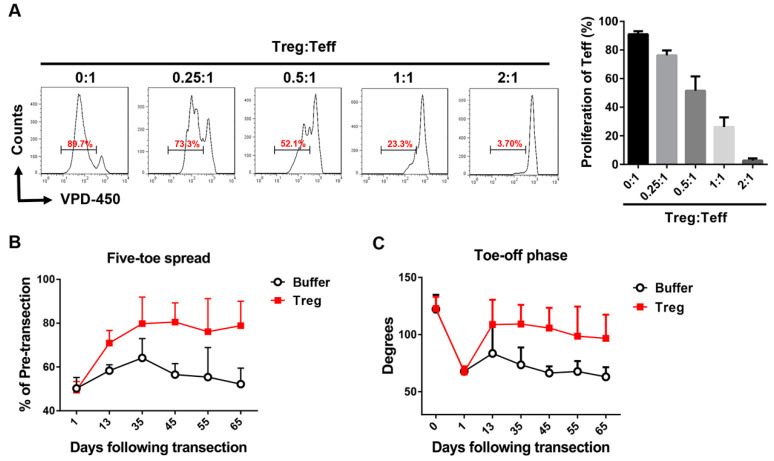Figure 5.
Treg administration improved the functional recovery of the sciatic nerve. (A) CD4+CD25+ Tregs (Treg) were isolated with a purity of >90% from naïve mice using a mouse CD4+CD25+ regulatory T cell isolation kit and an autoMACS instrument. CD4+CD25− effector T cells (Teff) were isolated with a purity of >90% using an autoMACS instrument. Tregs were co-cultured with VPD-450-labeled effector T cells under anti-CD3 (2 μg/mL) and anti-CD28 (2 μg/mL) stimulation for 3 days before analysis using flow cytometry. The difference between the mean ± SD values of the Treg mixture (0.25~2:1) and Teff (0:1) groups was significant in all cases (p < 0.005, Student’s t-test). (B) Tregs promoted the functional recovery of the five-toe spread reflex. Isolated Tregs (5 × 105) with a purity of >90% were added to the space created in the musculature of each mouse. Progressive chart of the percentage of the pre-transection five-toe spread distance measured over time after the division of the sciatic nerve in the buffer and Treg groups. The differences between the mean ± SD values of the two groups were significant (p value < 0.05, one-way ANOVA; Treg vs. buffer control, p = 0.02; Tukey’s test). The average five-toe spread in the normal mouse group was 9.950 ± 0.158 mm. (C) Tregs promoted gait-stance and movement improvement. The angles were measured in both groups after the transection surgery. Comparison of the mean ± SD values in the two groups revealed the presence of a significant difference (p value < 0.005, one-way ANOVA; Treg vs. buffer control, p = 0.01; Tukey’s test). The average angle of the normal mouse group was 122.5 ± 2.89.

